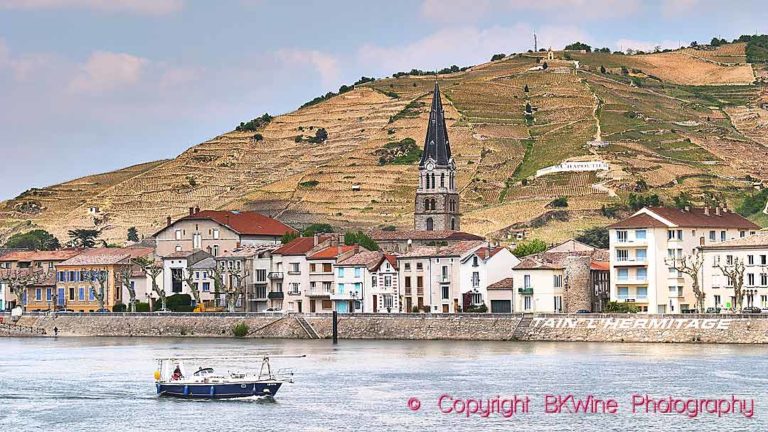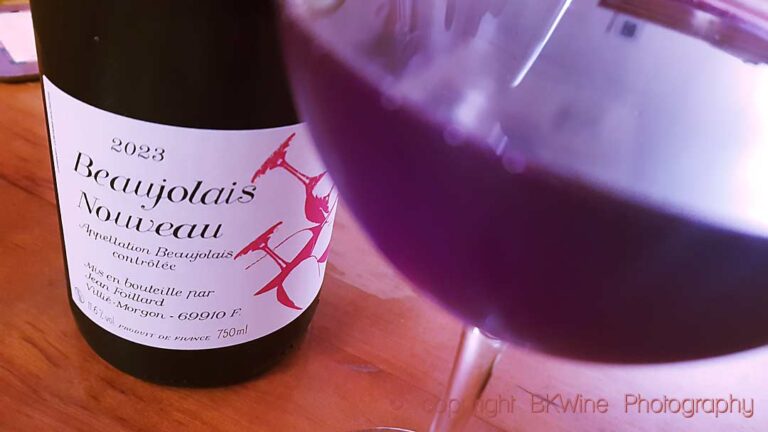This month we have selected two wines from Château de Moulin-à-Vent, a vineyard with a long history in the Beaujolais village of the same name. In addition, we have tasted new vintages of John Riddoch from Wynns in Coonawarra, Australia and the white Cairanne from Domaine Brusset.
“BKWine Tastes” is a collection of wines we have tasted recently. It is often samples that producers have sent us to show us what they do or other bottles that we have come across at tastings or on our tasting table in the office.
Château du Moulin à-Vent
Château du Moulin à-Vent is beautifully located in the northernmost part of Beaujolais, 70 kilometres south of Beaune. Moulin-à-Vent is one of the 10 villages with their own appellation in Beaujolais (often called cru). The appellation is based around the emblematic windmill, moulin-à-vent in French, proof that the wind blows diligently and dries up after the rain. Jean-Jacques Parinet and his son Edouard bought the historic Château du Moulin à-Vent in 2009 and now run it together with winemaker Brice Laffond.
The trio has identified six different grands terroirs, i.e., separate plots within their vineyard area. Overall, the soil consists of different types of granite soil that is more or less sandy, with different proportions of iron oxide, clay, and silicon. They bottle these six terroirs separately, a way to show that Beaujolais is a more complex wine than many would think. We have tasted one of these, Les Vérillats 2021. We have also tasted Les Terrasses du Château 2022, a blend of gamay grapes from different parts of the vineyard. The winery started its conversion to organic farming in 2022.
Les Terrasses du Château 2020, Château du Moulin-à-Vent, Moulin-à-Vent
A crisp and lively acidity that brings out the red berry flavours and aromas. Smooth tannins and a good body on the palate. Delicious and invigorating. (~17 euros).
Les Vérillats 2021, Château du Moulin-à-Vent, Moulin-à-Vent
Les Vérillats is a vineyard plot of 4.41 hectares with a windy location at an altitude of 300 meters. The soil is sandy and shallow (25-50 cm). In 2021, 6321 bottles of this wine were made. A delicious wine that has a gamay feel to it but with less overt and intense juiciness. Lovely fresh fruit, aromatic spices, plenty of herbal notes, long, enjoyable finish. A multifaceted gamay with a solid structure but also revealing the grape’s appealing side. (~33 euros).
Cairanne blanc Les Travers 2022, Domaine Brusset, Cairanne
Laurent Brusset runs Domaine Brusset in Cairanne, an appellation in the southern Rhône Valley best known for its red wines. However, we have tasted the new 2022 vintage of his white Cairanne. Laurent has had great success with this pleasant white wine. It is made from clairette, grenache blanc, roussanne and viognier. The wine has a rich and distinct taste; it is quite powerful, with notes of apricot and lemon. Mouth-filling and with a fresh finish. (~13 euros).
70% of the must ferments at 16 degrees C in steel tanks and the rest in new oak barrels with batonnage (lees stirring). The wine undergoes malolactic fermentation, a way to stabilize the wine, says Laurent. This white Cairanne is 10% of his total production which is a lot for the appellation. But demand for white Rhône wines is increasing.
Read here what we have previously written about Laurent Brusset and his wines.
John Riddoch Cabernet Sauvignon 2020, Wynns Coonawarra Estate, Australia
Coonawarra is located at the southernmost tip of South Australia. The area has long been known for its cabernet sauvignon, which grows in the red soil, terra rossa, which consists of weathered limestone and clay coloured red by iron oxide. The climate is cooler than many other places in Australia. Wynns is a legendary estate in Coonawarra, and John Riddoch is their prestige wine. Read here what we have previously written about the Wynns, John Riddoch and their winemaker Sue Hodder.
We have now tasted the new vintage of John Riddoch, 2020, which will be launched in September. 2020 was a vintage with plenty of rain during the winter and spring. However, the cold southerly winds during flowering were not entirely ideal, leading to lower yields. It was hot in December, otherwise temperatures were generally mild during the summer. The wine has rested for 17 months in French oak, 23% new barrels, the rest one and two years old. The colour is dense, the aroma big and concentrated with dark fruit, liquorice, and sweet dark cherries. The taste is intense, the body is more elegant than powerful, and the fruit is ripe but with a fresh acidity (a whopping 6.9 grams) and crunchy dark fruit. It is a very well-structured wine, and it is delicious.
It is young, of course, and can be aged for many years. We have tasted many older vintages of John Riddoch, all the way back to 1990, and know that they hold up wonderfully. But that does not stop them from being enjoyable when young, and that’s definitely the case with 2020. The grapes for John Riddoch are selected from the estate’s best cabernet sauvignon grapes. The grapes for this vintage come from ungrafted vines.














